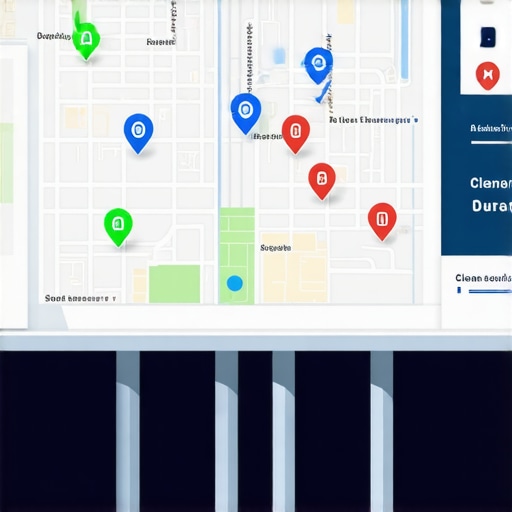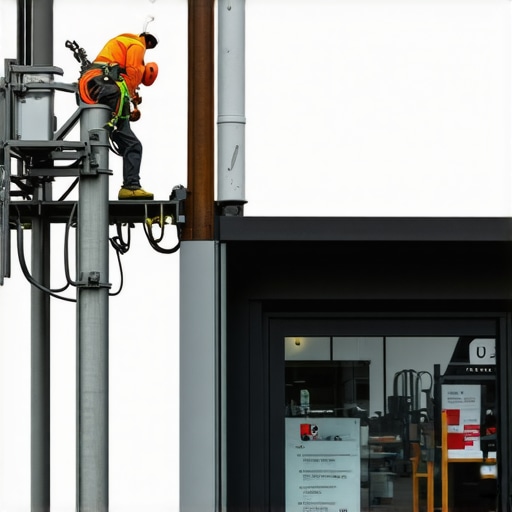
Master Local Ranking Growth with Expert GMB Signal Repair in 2024
My Unexpected Turnaround in Local SEO: A Personal Journey
Not long ago, I found myself scratching my head over why my local business wasn’t showing up in the coveted 3-pack on Google Maps. Despite my efforts, the rankings just wouldn’t budge. It was frustrating, but that frustration led me down a path of discovery that transformed my approach to local SEO.
Discovering the Power of GMB Signal Repair
Through a lot of trial and error—and a bit of research—I learned about the significance of GMB signal repair. This process is all about fixing and optimizing your Google My Business signals, which are crucial for climbing the local map pack. I started implementing strategies like cleaning up outdated info, resolving duplicate listings, and optimizing my GMB profile.
What Really Made a Difference?
One of the game-changers was understanding how GMB cleanup tips can boost your local search visibility. I meticulously removed irrelevant categories, corrected inconsistencies, and paid attention to NAP consistency across all directories. These tweaks significantly improved my local ranking, and I was amazed at the results.
Why Signal Repair is the Key to Local Success
In my experience, signal repair strategies aren’t just technical fixes—they’re a vital part of a broader local SEO strategy. Addressing issues like review signals, engagement metrics, and profile accuracy helps Google recognize your business as trustworthy and relevant. This holistic approach can propel your listing to the top of local results.
How Can I Tell if My GMB Signals Need Repair?
It’s a question I often get. If your business isn’t appearing in the local map pack or your rankings have stagnated, it might be time to review your GMB signals. Tools like Google’s My Business dashboard and third-party audit tools can help identify inconsistencies or issues that need fixing. Regular audits ensure your signals stay healthy and aligned with your SEO goals.
If you’re serious about boosting your local presence, I highly recommend exploring comprehensive GMB cleanup and signal repair strategies. Trust me, the effort pays off when you start seeing your business climb the local rankings.
Feeling inspired? Please share your experiences or questions below—I’d love to hear how you’re tackling local SEO challenges!
Decoding the Nuances of GMB Signal Optimization for Local Search Success
For seasoned local SEO practitioners, understanding the intricate web of GMB signals is essential. These signals encompass a broad spectrum—from NAP consistency and review signals to engagement metrics and profile completeness. Mastering their interplay can unlock unprecedented visibility in the local map pack. An often-overlooked aspect is the importance of ongoing GMB cleanup strategies, which serve as the foundation for effective signal repair.
Implementing a Holistic Signal Repair Strategy: Steps and Best Practices
Effective signal repair isn’t a one-and-done task; it requires a systematic approach. Begin with a comprehensive audit to identify inconsistencies across your GMB profile and external listings. Correct inaccuracies in contact information, categories, and business descriptions. Next, focus on review signals—responding promptly and encouraging authentic reviews can significantly enhance your profile’s credibility. Additionally, optimize your profile with high-quality images, accurate business hours, and relevant attributes.
To accelerate your local rankings, consider leveraging signal repair techniques that target specific issues. For example, resolving duplicate listings or outdated profiles can remove conflicting signals that dilute your authority. Regularly monitoring your GMB insights helps track the effectiveness of your efforts and adjust strategies accordingly.
How Do You Know When Your GMB Signals Are Truly Healthy?
Assessing signal health involves more than just visual inspection. Key indicators include consistent NAP data across directories, positive review trends, and engagement metrics such as click-through rates and calls. Using third-party audit tools or GMB insights can reveal hidden issues like inconsistent categories or missing information. Remember, a well-maintained profile not only improves rankings but also enhances user trust and conversion rates.
For a deeper dive into refining your local SEO strategy, explore our detailed guide on effective cleanup tactics. These efforts are your secret weapon for climbing the local search ladder and establishing authority in your niche.
Would you like to share your own experiences with GMB signal repair? Or perhaps you’re curious about advanced tactics? Drop a comment below—let’s learn from each other’s successes and challenges!
Deepening the Puzzle: How Do GMB Signals Interact in the Complex Web of Local SEO?
As I immersed myself further into the nuances of GMB signal repair, I realized that understanding the interplay between various signals is akin to decoding a intricate web. For example, how do review signals synergize with NAP consistency or engagement metrics? My experience taught me that optimizing one element without considering others often leads to subpar results. It’s like tuning a musical instrument — each string must be calibrated to harmonize with the rest.
One revelation was the importance of proven GMB signal repair techniques that target multiple signals simultaneously. This holistic approach ensures that Google perceives your business as a cohesive, trustworthy entity. For instance, consistently managing review responses while updating your profile with high-quality images creates a positive feedback loop, reinforcing your local relevance.
What Are the Hidden Nuances That Make Signal Repair Truly Effective?
From my journey, I’ve learned that the devil is in the details. Small discrepancies—like inconsistent address formats across directories or neglected review responses—can dilute your signals’ strength, hurting your rankings. A comprehensive GMB cleanup strategy involves meticulously auditing every aspect of your profile and citations, then harmonizing these signals to work in harmony.
Furthermore, leveraging tools that analyze your profile’s health can reveal subtle issues. For example, a sudden drop in engagement metrics might indicate a review spam attack or outdated information, which requires immediate attention. Regular audits help maintain the robustness of your signals over time, especially in a dynamic local search environment.
How Can I Elevate My Signal Repair Strategy to Stay Ahead in 2024?
This question has been central to my ongoing learning. The landscape is constantly shifting—Google’s algorithms evolve, and new signals emerge. To stay ahead, I’ve adopted a proactive mindset: continuous monitoring, testing new tactics, and staying informed through authoritative sources like industry-leading guides.
One advanced tactic I’ve found effective is the strategic use of structured data markup on your website to reinforce your GMB signals. This technical layer helps Google better understand your business’s context, boosting the signals that matter most. Additionally, fostering genuine engagement—such as encouraging reviews and responding authentically—can significantly influence your local rankings. Remember, Google values trust and relevance, which are built through ongoing, authentic interactions.
If you’re serious about mastering local SEO, I encourage you to dive deeper into effective cleanup tactics. These foundational steps are the bedrock for sophisticated signal repair strategies that can propel your business to the top of the local map pack.
What’s been your experience with GMB signal repair? Are there particular challenges or breakthroughs you’ve encountered? Share your story in the comments—I’d love to learn from your journey and exchange insights that could help us all elevate our local SEO game!
Deciphering the Subtle Interplay of GMB Signals in Local SEO Mastery
As I delved deeper into the intricacies of GMB signal repair, I uncovered that the true power lies in understanding how various signals—reviews, NAP consistency, engagement metrics—interact in a complex symphony. Optimizing these elements in isolation often yields limited results; instead, a holistic approach that orchestrates all signals harmoniously is essential. This realization was reinforced by insights from industry experts like Moz, emphasizing the importance of integrated signal management for local ranking success.
For example, ensuring review responses are genuine and timely not only boosts credibility but also enhances engagement signals, which in turn can positively influence other signals like profile completeness. Moreover, maintaining NAP consistency across all platforms prevents conflicting signals that can confuse Google’s algorithms. Such nuanced coordination creates a reinforcing feedback loop that elevates your local visibility to new heights.
What Are the Hidden Nuances That Make Signal Repair Truly Effective?
From my experience, the devil is indeed in the details. Minor discrepancies—such as inconsistent address formatting or overlooked review spam—can significantly undermine your efforts. A comprehensive GMB cleanup strategy involves meticulous auditing of every profile element and citation to harmonize signals. Regularly leveraging advanced audit tools can reveal subtle issues like duplicate listings or outdated information, allowing for targeted corrections that strengthen your overall signal profile.
One technique I found invaluable was implementing structured data markup on my website to reinforce my GMB signals. This technical step helps Google better understand my business context, amplifying the signals that matter most. Additionally, fostering genuine engagement through authentic reviews and thoughtful responses cultivates trust and relevance, which are critical in a competitive local landscape.
How Can I Elevate My Signal Repair Strategy to Stay Ahead in 2024?
Staying ahead requires proactive, continuous optimization. I’ve adopted a mindset of real-time monitoring and iterative testing, guided by authoritative sources like industry-leading guides. Implementing advanced tactics, such as leveraging schema markup and encouraging authentic reviews, keeps my profiles resilient against algorithm shifts.
Furthermore, integrating structured data on my website not only bolsters GMB signals but also improves click-through rates and user engagement. These interactions send positive signals back to Google, creating a virtuous cycle of ranking improvement. Remember, the landscape of local SEO is ever-evolving; continuous education and adaptation are your best tools for sustained dominance.
If you’re eager to deepen your understanding of these sophisticated techniques, I invite you to explore our detailed guide on effective cleanup tactics. Sharing your experiences or questions can spark insightful discussions—let’s elevate our local SEO game together!
Things I Wish I Knew Earlier (or You Might Find Surprising)
The Hidden Power of Consistency
One of the most overlooked aspects of GMB signal repair is the importance of consistency across all platforms. I used to focus solely on my GMB profile, but I realized that mismatched NAP details across directories can seriously dilute my signals. Regular audits have shown me that harmonizing information everywhere amplifies local rankings.
Reviews Are More Than Just Feedback
I used to think reviews were just for social proof, but I discovered they’re a crucial signal for Google. Responding promptly and encouraging genuine reviews helped me build trust and strengthened my profile’s relevance. It’s a simple step that has a surprisingly big impact.
Small Technical Tweaks Matter
Implementing structured data markup on my website seemed technical and intimidating at first, but it significantly reinforced my GMB signals. These small technical improvements created a more robust understanding of my business for Google, boosting my local visibility.
Don’t Underestimate the Power of Visuals
High-quality images and regular updates to your profile make a difference. I found that fresh visuals not only attract more clicks but also signal activity and engagement, which are positive ranking factors.
Monitoring Is a Continuous Process
Regularly checking insights and audit reports has become part of my routine. This vigilance helps catch issues early—like spammy reviews or duplicate listings—and keeps my signals healthy and effective.
Resources I’ve Come to Trust Over Time
- Google’s My Business Help Center: This official resource is comprehensive and always up-to-date, making it my first stop for understanding platform features and guidelines.
- Moz Local Search Ranking Factors: Moz’s insights into local SEO are credible and backed by data. I often revisit their guide to stay aligned with industry best practices.
- BrightLocal’s Local SEO Tools: Their audit tools are invaluable for identifying inconsistencies and tracking progress. I recommend them for anyone serious about signal health.
- GMBexorcist Blog: A fantastic source for deep dives into signal repair strategies, offering practical tips that I’ve found effective in my own efforts.
- Whitespark’s Citation Audit Tools: Ensuring citation accuracy is crucial, and Whitespark’s tools have helped me clean up and verify my listings efficiently.
Parting Thoughts from My Perspective
Mastering local SEO and GMB signal repair has been a journey of continuous learning. The key takeaway is that a holistic approach—combining profile optimization, review management, technical enhancements, and consistent monitoring—is essential for sustained success. I’ve seen firsthand how these strategies elevate local rankings and build trust with potential customers. If this resonates with you, I’d love to hear your thoughts or experiences. Sharing our stories can inspire new breakthroughs and help us all stay ahead in the ever-evolving world of local search. Feel free to drop your insights in the comments or share this with someone looking to boost their local visibility—together, we can master the art of local SEO.





4 Comments
Benjamin Carter
Reading about your personal journey with GMB signal repair really resonated with me. I recently started diving into local SEO myself and realized how crucial consistent and accurate GMB profiles are. I’ve seen a noticeable jump in my rankings just by cleaning up outdated info and optimizing my categories. Your point about holistic signal management really hit home—trying to boost one element without the others can lead to subpar results. One thing I’ve struggled with is managing reviews effectively and responding promptly. I’m curious—what’s your strategy for encouraging authentic reviews without seeming pushy? Also, do you use any specific tools to monitor signal health regularly? It seems like a continuous process, but I’d love to hear more about how others keep their signals in check long-term. Thanks for sharing your insights — it’s inspiring to see how consistent effort can pay off in local SEO!
Emily Johnson
Your personal story really highlights how powerful GMB signal repair can be when approached systematically. I remember when I first realized that just focusing on ranking my profile wasn’t enough; consistency across all my business listings played a huge role in improving visibility. One challenge I faced was managing reviews authentically without seeming overly promotional, which I think is tricky but essential for building trust. I mainly encourage organic reviews by providing exceptional service and subtly reminding satisfied customers to share their feedback. As for tools, I’ve been using BrightLocal’s audit platform to keep an eye on my signals and ensure everything is aligned, but I’d love to hear if anyone else has other recommendations or tips for maintaining long-term signal health. How do you guys balance active review management with day-to-day operations without feeling overwhelmed? Great insights—thanks for pushing the importance of a holistic approach to local SEO!
Liam Rodriguez
Reading your detailed journey into GMB signal repair really struck a chord with me. Managing a local business myself, I found that consistent NAP data across all directories was the easiest way to build trust with Google and improve rankings. I’ve also discovered that responding to reviews—both positive and negative—can boost engagement signals and showcase your active presence. I’m curious, how do you handle the ongoing process of monitoring and cleaning up signals without it becoming overwhelming? Do you have any tools or routines that make it easier to stay on top of everything? It’s clear that regular audits and proactive engagement are crucial, but finding that balance can be tricky. Thanks for sharing these insights; they’ve definitely motivated me to revisit my own GMB profile and keep refining my strategy. Would love to hear others’ experiences on maintaining signal health long-term as well!
Olivia Bennett
Your personal journey into GMB signal repair really resonated with me. I’ve been working on local SEO for my own business, and I’ve found that consistent NAP information across all platforms is one of the biggest factors in improving local rankings. The holistic approach you emphasized—addressing reviews, profile accuracy, and engagement—really makes a difference. I particularly agree that regular audits are crucial because Google’s algorithms are always changing. I’ve started using Whitespark’s citation tools to audit and correct inconsistencies, which has helped me maintain a strong signal profile. What’s been your experience with balancing review management and other optimization tasks? Do you have a routine or specific tools that help keep everything on track without feeling overwhelmed? Thanks for sharing such insightful strategies—this kind of comprehensive approach is exactly what’s needed in 2024 to stay ahead in local SEO.